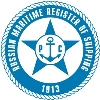 This is a full set of publications released by Russian Register of Shipping, all of the latest editions. The pack contains numerous publications arranged in five folders. The first folder contains the rules applicable to the classification and construction of sea-going vessels - twenty-six volumes are there including rules for the equipment, Load Line rules, and general regulations governing the classification as well as other activities.
The second pack contains rules other than those addressing sea-going ships - here you will find twenty-seven books including MODU rules, rules for transportation of grain, oil-and gas equipment of MODUs and fixed platforms, rules covering chemical tankers, LNG carriers, pleasure craft, subsea pipelines and production facilities, nuclear support vessels, inland navigation ships, high-speed craft, diving vessels and systems, marine operations rules, rules for classification of vessels in services and many others.
The third pack contains ten guidelines including the guidebook on MARPOL requirements, ships in service, Polar waters, MODUs, inland navigation ships, subsea pipelines, hazardous facilities and others. There are three publications in the fourth pack devoted to the ISM & ISPS Code while the last fifth pack contains Registers of ships and supplementary information.
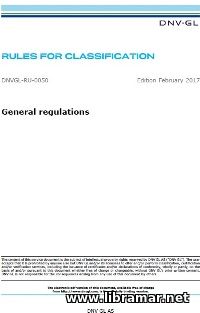 The content of the present officially released DNV GL document is dealing with the DNV, GL and DNV GL rules for classification of ships and MOUs (mobile offshore units), as well as the floating docks and yachts, HSC, standing for the high speed, and light crafts, underwater technology and vessels for inland navigation, plus naval vessels.
The document starts with the brief explanation of its purpose and main definitions used, followed with the description on application of the paper and relation existing between these rules and all other rules released by this class society. The third section of the document addresses the main classification principles including systematics, new construction and class entry, vessels in service and certification process to be followed for components and materials.
Three appendices provide the example of the standardized formatting of classification notations including qualifiers, general conditions and terms, and use of the product/material certificates that are used on DNV GL vessel rules conditions and exceptions. The document concludes with the list of historic changes. Note that this is the latest 2017 release of the document.
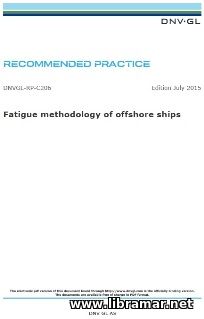 The publication is devoted to the fatigue methodology to be applied to the offshore vessels. The book opens with the list of definitions and Greek and Latin symbols followed with the brief but comprehensive overview of the hull fatigue analysis including the evaluation procedure, unit configuration, methodology of the spectral analysis, design fatigue factors and all other important aspects.
The next section is dealing with the selection of fundamental structural details to be used for the fatigue analysis; it is followed with the section providing the overview of the different modeling techniques including finite element methods, scantlings and FEM models, and it also covers the basic structural modeling principles, modeling of girders and stiffeners, mass modeling, model idealization, load transfer, extent of model etc.
The other sections of the document are dealing with the hydrodynamic loads, meteorological ocean criteria unit motion analysis, unit loading conditions, short term response analysis, general response, long term responses, hot spot analysis, fatigue design of the hull/turret interface and overview of the different designs and calculation methods, relevant documents and verification of fatigue analysis, fabrication issues, references and other useful information covering virtually all areas.
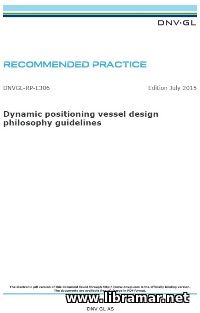 The DNV GL recommended practice dealing with the design philosophy for the vessels equipped with the dynamic positioning systems and providing required guidelines in this regard. The content of the present document reflects the results of close professional cooperation between the DNV GL classification society and the Technical Committee of the MTS, standing for the Marine Technology Society.
The intention of the authors was to provide readers with a sort of guiding document to help them with designing DP vessels. In the introductory section of the paper its purpose, layout and definitions used are provided together with the general guidance.
The main content of the guidelines has been arranged in several section dealing with the design philosophy including station keeping reliability, classes of the DP systems, associated class notations, responsibilities and functional requirements, autonomy, risk reduction, regulations, differentiation and diversity, capability of the systems, modeling matters addressing operability parameters, safety systems, power systems, analytical modeling etc., thrusters and applicable design criteria, control and testing requirements, power generation and distribution, marine systems, vessel management and all other important issues.
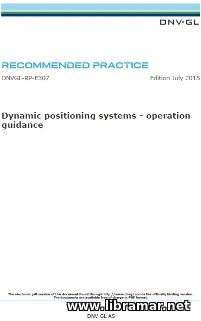 Another Recommended Practice released by DNV GL classification society. The objective of the present document is to provide all technical guidance required for the safe and effective management of the dynamic positioning operations. Such operations would normally include management, mitigation and reduction of the exposure to the dynamic positioning related incidents and exposure to them, identification of the themes required to be duly managed, provisions of a reference list addressing these themes.
Note that it is not the intention of the recommended practice to replace any of the rules. regulations or operation manuals. The content of the document is in fact a well compiled practical information and guidance gleaned from other respected sources of the maritime industry.
While the first section of the book is containing information focusing on the general management, the other four sections provide relevant guidance on DP, including dynamic positioning management guidance, i.e. related documents, DP class, failure modes, capability and footprint plots, checklist and trials, operational planning etc., operational guidance for ships and mobile offshore units, logistic vessels and any other aspects considered necessary for the efficient and safe working of such systems.
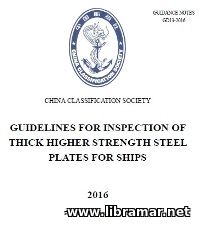 These Guidelines were specifically developed and published by China Register to govern the application of the high strength steels used for construction of the large ship hulls, having the yield stress of 460 N/mm2 or more. Brittle fractures can occur in structures made of extra thick higher strength steels. The present document provides measures to be implemented for prevention of the brittle fractures in such materials.
The content is arranged in five major section with the first one being introductory and providing general information, purpose of the guidelines, terms and definition, application and tests. Four chapters of the main body of the guidelines cover the approval and inspection of the H47 steel plates, brittle crack arrest steels - their application and inspection, and application of the extra thick high strength steels on container vessels.
There are three appendices at the end of the publication, providing necessary information about the standard ESSO tests, double tension tests and specimens that are normally used for the H47 steel approval tests. A needful reference source for people engaged in construction of ship hulls where the high strength steels of extreme thicknesses is utilized.
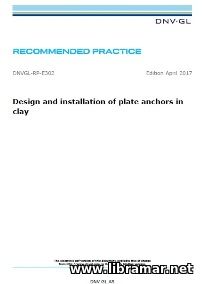 The DNV GL Recommended Practice covering the design and installation matters of the plate anchors in clay. The design method which has been outlined in the present document is mainly based on the results obtained in the course of two industry projects, namely design procedures and reliability analysis. Traditionally for all Recommended Practices that are regularly published by DNV GL class society, the document starts with the general information section giving all necessary introduction.
The chapters devoted to the design are covering the fundamental principles and design code including line tension, anchor resistance etc. The other chapters of the volume are dealing with the reliability analysis including target annual probabilities, installation aspects including effects on the depth of penetration and anchor rotation and keying, requirements to investigation of soil.
The Recommended Practice concludes with a list of references and numerous appendices addressing the characteristics and behavior of the anchors, informative and useful examples, testing issues, consolidation and cycling loading effects, target penetration depth and its prediction and other.
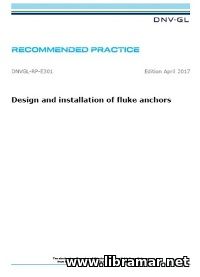 This is the latest revision of the Recommended Practice released by DNV GL class society and applying to the design and installation of the fluke anchors in clay intended for the catenary mooring systems. Note that the fundamental design and installation principles for the fluke anchors should be equally applicable to other soil types.
The guidebook opens with some introductory general information followed by the description of the main components of the fluke anchors and general behavior of this type of anchor. The following chapters of the document details the methodology used for the design of fluke anchors as well as recommended design procedure to be followed and requirements applicable to the soil investigation. The last chapter of the publication contains useful references.
There are several appendices to the main content of this Recommended Practice providing additional information on such important aspects of design and installation as analysis tool for the design, anchors in stiffer soil or layered clay, installation of the anchors and their testing, setup effect of their friction resistance, cyclic loading effect, and some others that shall all be duly considered.
« 1 2 ... 13 14 15 16 17 ... 29 30 » |







